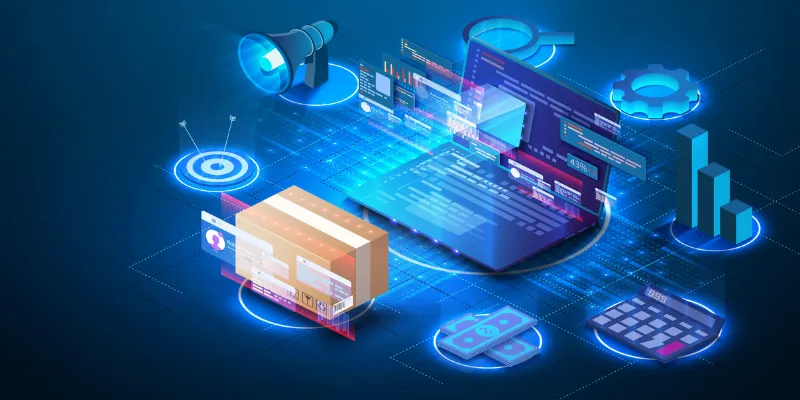How embracing tech has helped Indian MSMEs advance and grow
The MSME-related product export share of all India exports stood at 49.4 percent and 49.8 percent for FY21 and FY20, respectively. But the potential of the country’s MSME players could not have been tapped without the adoption of technology.
The Indian MSME story is one of courage, conviction, and change. Statistics reveal a spread of 63 million micro, small and medium enterprises (MSMEs) that form the backbone of India’s economy, contributing 30 percent to India’s GDP. Multiply MSMEs’ efforts with that of a government that wants to encash every available opportunity to support these businesses. The result is a clear road to true success for present and future generations.
MSME-related product export share of all India exports stood at 49.4 percent and 49.8 percent for FY21 and FY20, respectively. Budget allocation for MSMEs in FY22 more than doubled to Rs 15,700 crore vis-à-vis Rs 7,572 crore in FY21. These two show potential India sees in the country’s MSME players, which wouldn’t have been possible without the technology adoption ardently undertaken by the industry.
Armoured with the timely pivot to technology-led innovations via globally-acclaimed frameworks such as India Stack and Unified Payments Interface (UPI), as well as Aadhaar, Indian MSMEs have been reinventing themselves to marry their business needs and challenges with technological know-how and adoption to race forward.
Here are five key areas where technology has been used to bring about advancement:
Tech-led credit and lending
Disbursal of credit and loans to run the day-to-day requirements of an MSME unit is a bottleneck that has been first addressed with the advent of technology. As a result, in FY21, loan disbursals to MSMEs stood at Rs 9.5 trillion, a 40 percent increase compared with Rs 6.8 trillion in FY20.
The government’s schemes, such as a second loan for upgradation of existing PMEGP/MUDRA units, aim to provide existing units with upgradation assistance regarding expansion. Also, financial aid to well-performing units and the Credit Guarantee Scheme for Micro & Small Enterprises (CGTMSE) scheme are aimed at motivating first-generation entrepreneurs towards self-employment by providing credit guarantee funding for third-party guarantee-free or collateral-free loans. These are some of the examples of schemes made possible by technology.
The services sector has been addressed via schemes such as the Special Credit Linked Capital Subsidy Scheme (SCLCSS), enabling enterprises in the services sector to meet various technical requirements.
Apart from the government’s initiatives, many trade financing companies, banks, and financial institutions, including high-net-worth individuals, have designed credit and lending solutions that aid in pooling capital for credit-starved MSMEs to generate and distribute certain products and services popular globally. This has provided a fillip because of how well connected the globe has become due to technology.
Tech-led infrastructure and exports
Building a worldwide supply chain was unthinkable just a decade ago. Fast forward to times when the world saw its biggest pandemic in a century, and yet the flow of goods and services didn’t completely stop; it only halted until restrictions were eased.
With the help of technological tools and frameworks such as blockchain, the globe is now connected such that one could place an order in Vietnam, track it across continents to the US, deliver it to Mexico, and collect payments from France. Artificial intelligence and machine learning have made processes reliable and leak-proof.
Predictive analytics tools promise continuity of contracts and ensure their deliveries are fully taken care of. Such an advanced way of conducting trade is the gift of using real-time technology to address infrastructure and complete business cycles.

Tech-led marketing and sales
Building products and services are one aspect, and taking the end product to the world is another. Retail giants have proven what well-oiled goods and services machinery can do to address global consumption and their presence in India is no exception.
Initiatives such as the Government’s e-Marketplace (GeM), from where ministries and public sector undertakings source their procurement, help MSMEs market their offerings like never before. For instance, as of March 24, 2022, the GeM portal has served 9.63 million orders worth Rs 219,071 crore from four million registered sellers and service providers for 59,259 buyer organisations. This is testimony to how technology-led marketing single-handedly ensures Indian MSMEs thrive in all ecosystems worldwide.
Moreover, the Procurement and Marketing Support (PMS) scheme is also aimed at developing the marketability of services and products in the MSME sector. It promotes access initiatives and awareness about various marketing relevant topics. This also shows the advances technology has helped Indian MSMEs make towards a more globalised trade environment.
Tech-led payments and settlements
Data suggests Indian MSMEs are rapidly adopting digital payments over cash, with 72 percent of payments done through the digital mode compared with 28 percent of cash transactions earlier. This has been made possible only with the advent of technology-led payments solutions, an area where India has been a world leader via the NPCI’s efforts.
Agility in being able to receive and make payments makes for a solid case for the world to interact with each other for trade. It solves not only a business problem but also ensures trust and commitments in payment cycles and settlements. Such processes present a brilliant opportunity for Indian MSMEs who have quickly adapted to digital methods of payments and are keen to learn more rapidly.
Tech-led training and skill-building
At the core of real growth are succession plans. The technology used today will decide what Indian MSMEs will learn in the future.
Many progressive government-led schemes such as the Lean Manufacturing Competitiveness for MSMEs scheme aimed at enhancing the manufacturing competitiveness of MSMEs, the Entrepreneurship and Skill Development Programme (ESDP) scheme aimed at promoting new enterprises and enable/facilitating capacity building of existing MSMEs, to name a few, have been possible only with the help of technology-led solutions.
The sooner Indian MSMEs embrace such initiatives, the faster the skill-building process will help them leapfrog in a highly competitive global arena.
Conclusion
The role of technology can no longer be shrugged off by Indian MSMEs, who will be front-runners in building India 2.0. Make in India, Digital India, and Skill India all point towards one common goal: empowering the backbone of the economy.
To become a tale of true success, Indian MSMEs must embrace what lies ahead of them, build resilient business models, and create a future to further technology, by technology, and for technology.
Edited by Teja Lele
(Disclaimer: The views and opinions expressed in this article are those of the author and do not necessarily reflect the views of YourStory.)









